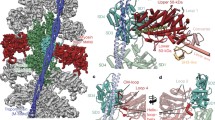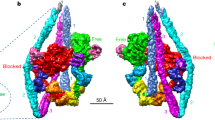Summary
The effects of N-ethylmaleimide (NEM) and other sulfhydryl modifiers on the structure of skinned frog skeletal muscles were studied using the X-ray diffraction technique. In sartorius muscle with full overlap between the thick and thin filaments, 0.1-1.0 mM NEM changed the intensity ratio of the (1,0) and (1,1) equatorial reflections from 4.35 to 0.72, and the (1,0) spacing of the hexagonal filament lattice from 40.4 to 41.4 nm. The axial X-ray diffraction pattern showed weak myosin layer-lines after the NEM treatment but enhancement of the actin layer-lines was not observed. In overstretched semitendinosus muscle, NEM did not affect the equatorial spacing but the myosin layer-lines were weakened. These results indicate that modification of myosin by NEM destroys the helical arrangement of myosin heads around the shaft of the thick filament and that when thin filaments are available, myosin heads move towards, and possibly bind to them. This binding is different from that in rigor since the ‘ladder-like’ appearance of the higher actin layer-lines, which is typical of patterns from rigor muscles, was not observed. On removal of ATP after the NEM treatment, the diffraction pattern showed features characteristic of that from normal rigor muscles but no tension was produced. The pattern showed well-defined samplings on layer-lines in the small-angle region, indicating the presence of an extensive lattice order and exact axial alignment of the filaments. The first actin layer-line did not show samplings from the superlattice of the thick filaments, which are observed on the myosin layer-lines in patterns from resting muscles. This indicates that in NEM-treated rigor muscles the pattern of binding of myosin heads to the thin filaments is not influenced by the azimuthal orientation of the thick filament.
Similar content being viewed by others
References
Amemiya, Y., Wakabayashi, K., Hamanaka, T., Wakabayashi, T., Matsushita, T. &Hashizume, H. (1983) Design of a small-angle X-ray diffractometer using synchrotron radiation at the Photon Factory.Nucl. Instr. Meth. 208, 471–7.
Amemiya, Y., Wakabayashi, K., Tanaka, H., Ueno, Y. &Miyahara, J. (1987) Laser-stimulated luminescence used to measure X-ray diffraction of a contracting striated muscle.Science 237, 164–8.
Brenner, B. &Yu, L. C. (1985) Equatorial X-ray diffraction from single skinned rabbit psoas fibres at various degrees of activation.Biophys. J. 48, 829–34.
Cooper, J. A. &Pollard, T. D. (1982) Methods to measure actin polymerization.Methods Enzymol. 85, 182–210.
Ebashi, S., Kodama, A. &Ebashi, F. (1968) Troponin. I. Preparation and physiological function.J. Biochem. 64, 465–77.
Endo, M. &Iino, M. (1980) Specific perforation of muscle cell membranes with preserved SR functions by saponin treatment.J. Muscle Res. Cell Motility 1, 89–100.
Fryer, M. W., Neering, I. R. &Stephenson, D. G. (1988) Effects of 2,3-butanedione monoxime on the contractile activation properties of fastand slow-twitch rat muscle fibres.J. Physiol 407, 53–75.
Haselgrove, J. C. (1975) X-ray evidence for conformational change in the myosin filaments of vertebrate striated muscle.J. Mol. Biol. 92, 113–43.
Haselgrove, J. C. &Huxley, H. E. (1973) X-ray evidence for radial cross-bridges movement and for the sliding filament model in actively contracting skeletal muscle.J. Mol. Biol. 77, 549–68.
Higuchi, H. &Takemori, S. (1989) Butanedione monoxime suppresses contraction and ATPase activity of rabbit skeletal muscle.J. Biochem. 105, 638–43.
Hirose, K. &Wakabayashi, T. (1988) Thin filaments of rabbit skeletal muscle are in helical register.J. Mol. Biol. 204, 797–801.
Huxley, H. E. (1968) Structural difference between resting and rigor muscle; evidence from intensity changes in the low-angle equatorial X-ray diagram.J. Mol. Biol. 37, 507–20.
Huxley, H. E. &Brown, W. (1967) The low-angle X-ray diagram of vertebrate striated muscle and its behaviour during contraction and rigor.J. Mol. Biol. 30, 383–434.
Irving, T. C. &Millman, B. M. (1989) Changes in thick filament structure during compression of the filament lattice in relaxed frog sartorius muscle.J. Muscle Res. Cell Motil. 10, 385–96.
Kress, M., Huxley, H. E., Faruqi, A. R. &Hendrix, J. (1986) Structural changes during activation of frog muscle studied by time-resolved X-ray diffraction.J. Mol. Biol. 188, 325–42.
Luther, P. K. &Squire, J. C. (1980) Three-dimensional structure of the vertebrate A-band. II. The myosin filament superlattice.J. Mol. Biol. 141, 409–30.
Magid, A. &Reedy, M. K. (1980) X-ray diffraction observations of chemically skinned frog skeletal muscle processed by an improved method.Biophys. J. 30, 27–40.
Matsubara, I., Yagi, N. &Hashizume, H. (1975) Use of an X-ray television for diffraction of the frog striated muscle.Nature 255, 728–9.
Matsubara, I., Goldman, Y. E. &Simmons, R. M. (1984) Changes in the lateral filament spacing of skinned muscle fibres when crossbridges attach.J. Mol. Biol. 173, 15–33.
Matsubara, I., Umazume, Y. &Yagi, N. (1985) Lateral filamentary spacing in chemically skinned murine muscles during contraction.J. Physiol. 360, 135–48.
Reisler, E. (1982) Sulfhydryl modification and labeling of myosin.Methods Enzymol. 85, 84–93.
Rome, E., Offer, G. &Pepe, F. A. (1973) X-ray diffraction of muscle labelled with antibody to C-protein.Nature New Biol. 244, 152–4.
Seidel (1982) Electron paramagnetic resonance of contractile proteins.Methods Enzymol. 85, 594–624.
Schoenberg, M. (1980) Geometrical factors influencing muscle force development. I. The effects of filament spacing upon axial forces.Biophys. J. 30, 51–68.
Squire, J. M. &Harford, J. J. (1988) Actin filament organization and myosin head labelling patterns in vertebrate skeletal muscles in the rigor and weak binding states.J. Muscle Res. Cell Motil 9, 344–58.
Williams, D. L. &Swenson, C. A. (1982) Disulphide bridges in tropomyosin. Effect on ATPase activity of actomyosin.Eur. J. Biochem. 127, 495–9.
Yagi, N. &Matsubara, I. (1989) Structural changes in the thin filament during activation studied by X-ray diffraction of highly stretched skeletal muscle.J. Mol. Biol. 208, 359–63.
Yu, L. C. &Brenner, B. (1989) Structures of actomyosin crossbridges in relaxed and rigor muscle fibres.Biophys. J. 55, 441–53.
Author information
Authors and Affiliations
Rights and permissions
About this article
Cite this article
Yagi, N. Effects of N-ethylmaleimide on the structure of skinned frog skeletal muscles. J Muscle Res Cell Motil 13, 457–463 (1992). https://doi.org/10.1007/BF01738040
Received:
Revised:
Accepted:
Issue Date:
DOI: https://doi.org/10.1007/BF01738040




